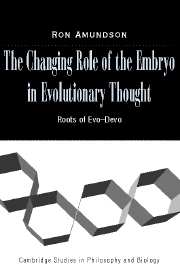Book contents
- Frontmatter
- Contents
- Acknowledgments
- 1 Introduction
- PART I DARWIN'S CENTURY: BEYOND THE ESSENTIALISM STORY
- 2 Systematics and the Birth of the Natural System
- 3 The Origins of Morphology, the Science of Form
- 4 Owen and Darwin, The Archetype and the Ancestor
- 5 Evolutionary Morphology: The First Generation of Evolutionists
- 6 Interlude
- PART II NEO-DARWIN'S CENTURY: EXPLAINING THE ABSENCE AND THE REAPPEARANCE OF DEVELOPMENT IN EVOLUTIONARY THOUGHT
- References
- Index
4 - Owen and Darwin, The Archetype and the Ancestor
Published online by Cambridge University Press: 05 June 2012
- Frontmatter
- Contents
- Acknowledgments
- 1 Introduction
- PART I DARWIN'S CENTURY: BEYOND THE ESSENTIALISM STORY
- 2 Systematics and the Birth of the Natural System
- 3 The Origins of Morphology, the Science of Form
- 4 Owen and Darwin, The Archetype and the Ancestor
- 5 Evolutionary Morphology: The First Generation of Evolutionists
- 6 Interlude
- PART II NEO-DARWIN'S CENTURY: EXPLAINING THE ABSENCE AND THE REAPPEARANCE OF DEVELOPMENT IN EVOLUTIONARY THOUGHT
- References
- Index
Summary
INTRODUCTION
Richard Owen was the most prominent and respected British naturalist of the 1840s and 1850s, and he was an active researcher for nearly sixty years. He was the transcendental anatomist who was closest to Darwin while Darwin's theory was being formulated. For this reason, he was important to Part 2 of the Origin, the argument for the fact of common descent. Owen's reputation was first established as a Cuvierian functionalist, a mode of thought that coincided nicely with the Bridgewater generation of natural theology. During the 1840s he followed the structural turn of many British naturalists toward continental morphology (Chapter 3, Section 3.4). He gathered, organized, and continued the work of idealist morphologists. He presented it to the public in an orderly and a quite empiricist-sounding style. He clarified the concepts of homology and analogy, he revised and rationalized the system of the naming of bones of the vertebrate skeleton, he articulated three distinct kinds of homology, and out of these he constructed the Vertebrate Archetype. He acknowledged the work of the continental morphologists, but he was careful to distance himself from their perceived excesses. In this way he was able to present his own version of the morphological results as the result of careful induction, and not idealist speculation. The least recognized of Owen's achievements (especially among modern commentators) is that he associated Unity of Type and the Vertebrate Archetype with a naturalistic cause of the origin of species.
- Type
- Chapter
- Information
- The Changing Role of the Embryo in Evolutionary ThoughtRoots of Evo-Devo, pp. 76 - 106Publisher: Cambridge University PressPrint publication year: 2005



